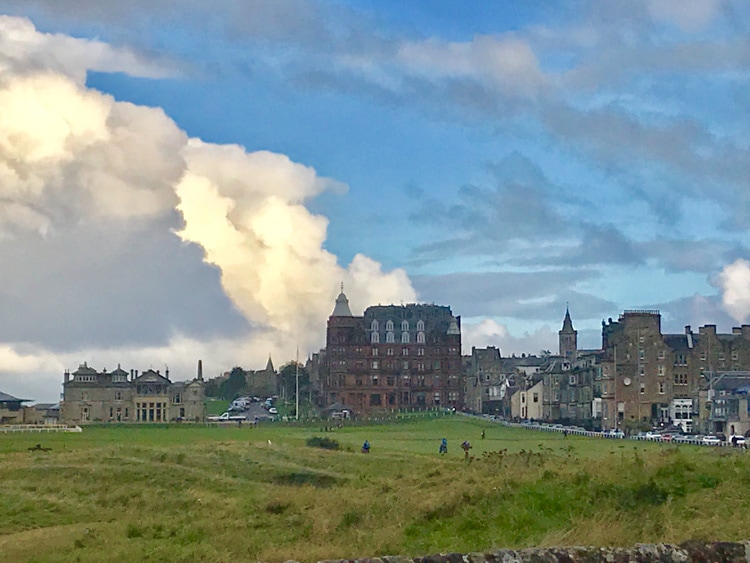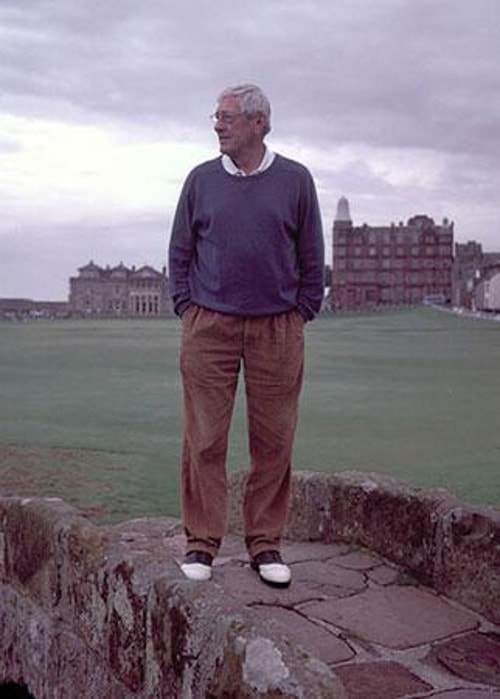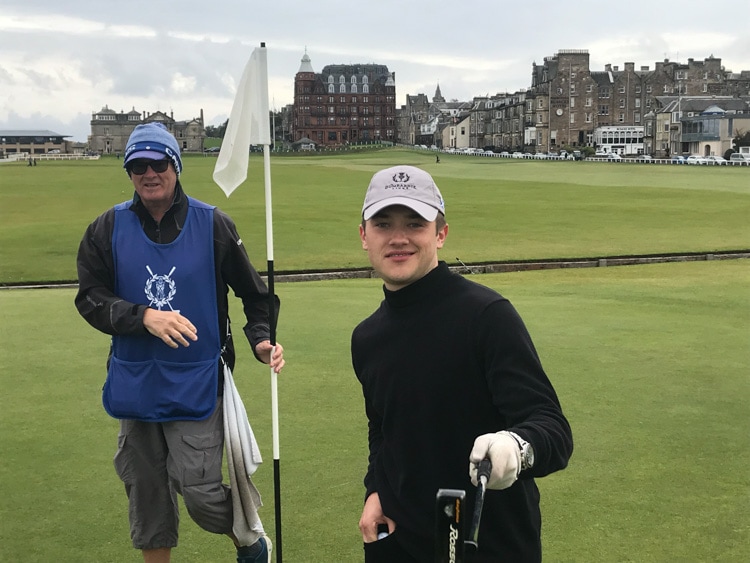I have, in a series of columns, let my mind and keyboard wander across some of the destinations in which I have experienced some situational sweetness.
Golfers from around the world make pilgrimages to St. Andrews, Scotland, because it is recognized as the birthplace of golf. Recognizable, too, is the golf course, because the treeless, links-style layout hosts the Open Championship (British Open) every five years on international television.
Its holes begin and end right in the corner of the medieval town, which is dominated by golf tourism and the university that educated, among others, Prince William, who will one day be king.
Accomplished American golf course architect Arthur Hills allowed me to shadow him for a walk around the links on a grey summer day in 2005, along with some of his designers and his public relations man, Quentin Lutz.

ACCOMPLISHED GOLF COURSE ARCHITECT
I was observing Hills because I was, as a golf writer, in the process of collaborating on his autobiography, “The Works of Art.” A book that included descriptions of his more than 200 golf course designs around the world.
I previously authored the autobiography of CBS Sports television golf commentator Ben Wright, the British voice of the Emmy Award-winning telecasts of The Masters and other televised PGA Tour events. That book, which received a lot of media attention and great reviews, was called “Good Bounces and Bad Lies.”
A round of golf on the Old Course at St. Andrews, for anyone who plays it or even gets near it, includes souvenir selfies and photo-taking at the Swilcan Bridge. A stone’s throw from the Old Course Hotel and Jigger Inn, the Swilcan Bridge is a little, ancient stone stairway that bumps across the burn, which intersects the first and 18th holes.
This would not be the only bridge that would come into play on our day.

THE LAST HURRAH
The grey hair of Arthur Hills matched the sky color when he stopped, with a professional photographer in tow, to pose for photos at the Swilcan Bridge. He was a golf design potentate who, at age 75, invested considerable financial resources ($85,000) and spent valuable time sharing his wisdom with his younger design team staffers. He was patient as the photographer and I sought to chronicle and document his every step and utterance.
As Hills stood on the bridge, his sweater was blue, but his mood was not. He knew, as everyone in golf and media do, that world-famous, aging golfers making their last appearances in the Open Championship at St. Andrews traditionally stop for photos, symbolically waving “goodbye” from atop its tiny span.
“I guess this is my last ‘hurrah,’” Hills said quietly.
He was very fit and in good health, but he admitted that he could not imagine a return to Scotland as his international travel from his Toledo, Ohio home was becoming very infrequent. His younger partner, Steve Forrest still relished the road, and Hills seemed content with that collaboration.
Upon hearing Hills, the small, gathered group let the moment sit in quiet. Hills peered across the linksland out to the sea, where a sliver of sky on the horizon had turned to a glowing orange as the sun sunk. We were in the gloaming and Hills was in his glory.
NIGHTLIFE AFTER DARK
After a customary post-round pint at the Dunvegan Pub behind the Old Course’s 18th green, Hills headed to bed back at our boutique inn just around the corner.
Lutz, the public relations man for Hills and the firm, joined me as we walked the town for some after-dark nightlife.
Tennents is Scotland’s favorite beer, but drinking with the very tall Lutz, who had previously served in the Navy and then been a procurement executive in the auto industry, meant we moved on to single malt whiskies. We walked down into the seemingly subterranean Ma Bell’s bar, which was lively still as midnight neared.
In the British Isles, a gathering of women is sometimes called a “Hen Party,” which is exactly what Lutz and I stumbled into. A gathering of “birds,” as the British might also say. In addition to being much taller and fitter, Lutz was, by traditional standards, the more handsome of the two of us. He was married, though, so he did not mind playfully bird-dogging for me with women, especially because he knew that while he had me on looks, I was far, far funnier than him. So, Lutz and I ham-and-egged it for amusement while in the pubs.

MEET THE AUTHOR
Through sheer proximity in the crowded, lively bar, we began talking to a group of four middle-aged Scottish women who were dressed up for a night on the town. I don’t recall if there was any occasion beyond that, but a woman named Lynne with a strong Fife accent seemed to be the group’s “Horatio” and chief spokesperson.
We quipped along in the smallest of talk, which I imagine the ladies tolerated if not engaged in because of our American accents. The women had surely endured their share of American golf groups bussing into town to plunder the area’s many high-profile golf courses, including, now, the two courses up at the Fairmont Hotel and the newest – Dumbarnie Links. Scotties can spot the tourist Yanks a mile away by their logoed golf apparel.
Perhaps that’s why Lutz decided to set us apart by enticing the ladies with a little hyperbole.
“This guy here,” he told them while throwing his arm around my neck, “is a famous American author.”
The women reacted very positively and enthusiastically to what was, in truth, a highly exaggerated claim. A couple of niche golf books did not deserve such a description. Maybe more than anything, the women were relieved they might have something to talk about with these two golfers as opposed to listening to Lutz and I recount the shots we hit and scores we made that day on the course.

ARE YOU FAMOUS?
Their ears perked up because perhaps there was possibly something novel about me, pardon the pun.
“A famous American author?” Lynne asked.
I visibly shrugged and demurred.
“Now, now, don’t be shy,” Lutz insisted, patting my shoulder. “You know you’re an acclaimed, bestselling author.”
Now the ladies were all atwitter.
“Really?”
Again, I winced.
“Really,” Lutz answered them. “He’s being modest.”
I took a sip of my whisky.
“Would I have read your book? Is it in the shoppe?” one of the women asked.
“Maybe. I don’t know,” I answered.
Then Lynne, who was pretty in pink, took over the questioning in a direct fashion. “Aw come on now. What is your book about?”
I looked into her deep eyes and answered, “Oh, I doubt you would have heard about it over here in Scotland,” I replied.
“Tell us. Maybe we have read it,” she insisted as the others listened. I saw Lutz taking a swig of scotch and awaiting my answer, also.

THE CON
“Eh, well, it is a book about these people who find some photos in a trunk after their mother dies,” I said.
“Go on,” Lynne said.
“She’s Italian, but she lived in middle America.”
“And?”
“They are surprised, when they look at the pictures, to learn their mother had befriended a man.”
Lynne was listening.
“She met the man when he traveled through their remote, rural town,” I continued.
Now Lynne was nodding and the other women were wide-eyed, so I kept going.
“The man was a photographer, and they had a brief, secret romance…”
“‘THE BRIDGES OF MADISON COUNTY!’” Lynne screamed out as her friends cooed and giggled. “You are the author of the ‘Bridges of Madison County?’”
“Oh my god,” another of the women shrieked.
I saw Lutz almost spit out his scotch.
“Of course we have heard of it,” Lynne said. “Wow! ‘Bridges of Madison County’ is your book. You are the author?”
“Well…maybe,” I said quietly with another modest, vague shrug. And another sip.
It would have broken the ladies’ hearts to dampen their ardor and tell them I was pulling their collective legs. So, Lutz and I let the con play out and let them have a story to tell when they went home that night.
I don’t know if author Robert James Waller ever made it to St. Andrews, Scotland, for a book signing of his “The Bridges of Madison County” before he died in 2017. But if he did, he and those lassies were in for a rude awakening.


